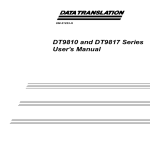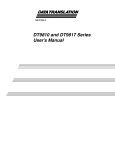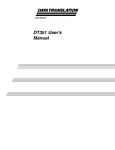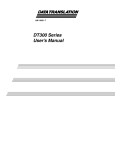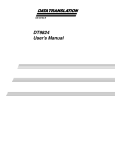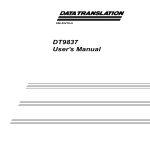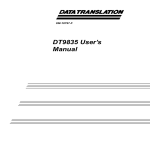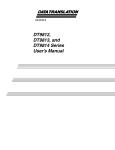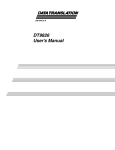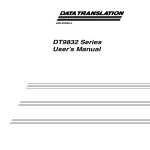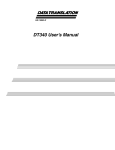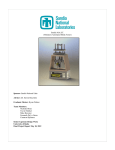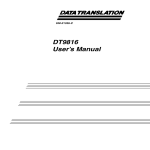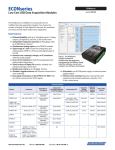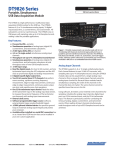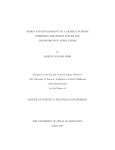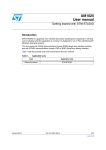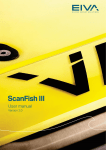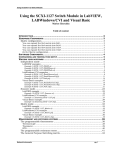Download DT 9816 User Manual
Transcript
UM-21336-F DT9816 User’s Manual Sixth Edition May, 2007 Copyright © 2006 - 2007 by Data Translation, Inc. All rights reserved. Information furnished by Data Translation, Inc. is believed to be accurate and reliable; however, no responsibility is assumed by Data Translation, Inc. for its use; nor for any infringements of patents or other rights of third parties which may result from its use. No license is granted by implication or otherwise under any patent rights of Data Translation, Inc. Use, duplication, or disclosure by the United States Government is subject to restrictions as set forth in subparagraph (c)(1)(ii) of the Rights in Technical Data and Computer software clause at 48 C.F.R, 252.227-7013, or in subparagraph (c)(2) of the Commercial computer Software Registered Rights clause at 48 C.F.R., 52-227-19 as applicable. Data Translation, Inc., 100 Locke Drive, Marlboro, MA 01752 Data Translation, Inc. 100 Locke Drive Marlboro, MA 01752-1192 (508) 481-3700 www.datatranslation.com Fax: (508) 481-8620 E-mail: [email protected] Data Translation® is a registered trademark of Data Translation, Inc. DT-Open LayersTM, DT-Open Layers for .NET Class LibraryTM, DataAcq SDKTM, OMNI CDTM, LV-LinkTM, and DTx-EZTM are trademarks of Data Translation, Inc. All other brand and product names are trademarks or registered trademarks of their respective companies. Radio and Television Interference This equipment has been tested and found to comply with CISPR EN55022 Class A, and EN50082-1 (CE) requirements and also with the limits for a Class A digital device, pursuant to Part 15 of the FCC Rules. These limits are designed to provide reasonable protection against harmful interference when the equipment is operated in a commercial environment. This equipment generates, uses, and can radiate radio frequency energy and, if not installed and used in accordance with the instruction manual, may cause harmful interference to radio communications. Operation of this equipment in a residential area is likely to cause harmful interference, in which case the user will be required to correct the interference at his own expense. Changes or modifications to this equipment not expressly approved by Data Translation could void your authority to operate the equipment under Part 15 of the FCC Rules. Note: This product was verified to meet FCC requirements under test conditions that included use of shielded cables and connectors between system components. It is important that you use shielded cables and connectors to reduce the possibility of causing interference to radio, television, and other electronic devices. Canadian Department of Communications Statement This digital apparatus does not exceed the Class A limits for radio noise emissions from digital apparatus set out in the Radio Interference Regulations of the Canadian Department of Communications. Le présent appareil numérique n’émet pas de bruits radioélectriques dépassant les limites applicables aux appareils numériques de la class A prescrites dans le Règlement sur le brouillage radioélectrique édicté par le Ministère des Communications du Canada. Table of Contents About this Manual . . . . . . . . . . . . . . . . . . . . . . . . . . . . . . . . . . 9 Intended Audience. . . . . . . . . . . . . . . . . . . . . . . . . . . . . . . . . . . . . . . 9 How this Manual is Organized . . . . . . . . . . . . . . . . . . . . . . . . . . . 10 Conventions Used in this Manual . . . . . . . . . . . . . . . . . . . . . . . . . 11 Related Information . . . . . . . . . . . . . . . . . . . . . . . . . . . . . . . . . . . . . 11 Where To Get Help. . . . . . . . . . . . . . . . . . . . . . . . . . . . . . . . . . . . . . 12 Chapter 1: Overview . . . . . . . . . . . . . . . . . . . . . . . . . . . . . . . 13 Key Hardware Features . . . . . . . . . . . . . . . . . . . . . . . . . . . . . . . . . 14 Simultaneous Analog Inputs . . . . . . . . . . . . . . . . . . . . . . . . . . 14 Counter/Timer Channel . . . . . . . . . . . . . . . . . . . . . . . . . . . . . 15 Clocks and Triggers. . . . . . . . . . . . . . . . . . . . . . . . . . . . . . . . . . 15 Supported Software . . . . . . . . . . . . . . . . . . . . . . . . . . . . . . . . . . . . . 15 Getting Started Procedure. . . . . . . . . . . . . . . . . . . . . . . . . . . . . . . . 17 Part 1: Getting Started . . . . . . . . . . . . . . . . . . . . 19 Chapter 2: Preparing to Use a Module. . . . . . . . . . . . . . . . . 21 Unpacking . . . . . . . . . . . . . . . . . . . . . . . . . . . . . . . . . . . . . . . . . . . . 22 Checking the System Requirements . . . . . . . . . . . . . . . . . . . . . . . 23 Installing the Software . . . . . . . . . . . . . . . . . . . . . . . . . . . . . . . . . . 24 Chapter 3: Setting Up and Installing the Module . . . . . . . . 27 Attaching Modules to the Computer . . . . . . . . . . . . . . . . . . . . . . 29 Connecting Directly to the USB Ports . . . . . . . . . . . . . . . . . . 30 Connecting to an Expansion Hub . . . . . . . . . . . . . . . . . . . . . . 31 Changing the Name of a Module (Optional) . . . . . . . . . . . . . . . . 33 5 Contents Chapter 4: Wiring Signals to the Module. . . . . . . . . . . . . . . 35 Preparing to Wire Signals . . . . . . . . . . . . . . . . . . . . . . . . . . . . . . . . 37 Wiring Recommendations . . . . . . . . . . . . . . . . . . . . . . . . . . . 37 Wiring Locations . . . . . . . . . . . . . . . . . . . . . . . . . . . . . . . . . . . 37 Connecting Single-Ended Analog Input Signals . . . . . . . . . . . . . 39 Connecting Digital I/O Signals . . . . . . . . . . . . . . . . . . . . . . . . . . . 40 Connecting Counter/Timer Signals . . . . . . . . . . . . . . . . . . . . . . . 41 Connecting Signals for Event Counting . . . . . . . . . . . . . . . . 41 Connecting Signals for Frequency Measurement . . . . . . . . 43 Connecting Signals for Rate Generation . . . . . . . . . . . . . . . . 44 Chapter 5: Verifying the Operation of a Module . . . . . . . . . 45 Installing the Quick DataAcq Application . . . . . . . . . . . . . . . . . 47 Running the Quick DataAcq Application . . . . . . . . . . . . . . . . . . 47 Testing Single-Value Analog Input . . . . . . . . . . . . . . . . . . . . . . . . 48 Testing Continuous Analog Input . . . . . . . . . . . . . . . . . . . . . . . . 49 Testing Single-Value Digital Input . . . . . . . . . . . . . . . . . . . . . . . . 50 Testing Single-Value Digital Output . . . . . . . . . . . . . . . . . . . . . . . 51 Testing Frequency Measurement . . . . . . . . . . . . . . . . . . . . . . . . . 52 Testing Pulse Output . . . . . . . . . . . . . . . . . . . . . . . . . . . . . . . . . . . . 53 Part 2: Using Your Module . . . . . . . . . . . . . . . . . 55 Chapter 6: Principles of Operation . . . . . . . . . . . . . . . . . . . 57 Analog Input Features . . . . . . . . . . . . . . . . . . . . . . . . . . . . . . . . . . . 59 Input Resolution . . . . . . . . . . . . . . . . . . . . . . . . . . . . . . . . . . . . 59 Analog Input Channels . . . . . . . . . . . . . . . . . . . . . . . . . . . . . . 59 Specifying a Single Analog Input Channel . . . . . . . . . 60 Specifying One or More Analog Input Channels . . . . 60 Input Ranges and Gains . . . . . . . . . . . . . . . . . . . . . . . . . . . . . 60 Input Sample Clock Sources . . . . . . . . . . . . . . . . . . . . . . . . . . 61 6 Contents Analog Input Conversion Modes . . . . . . . . . . . . . . . . . . . . . 61 Single-Value Operations . . . . . . . . . . . . . . . . . . . . . . . . . 61 Continuous Scan Mode . . . . . . . . . . . . . . . . . . . . . . . . . . 62 Input Triggers . . . . . . . . . . . . . . . . . . . . . . . . . . . . . . . . . . . . . . 63 Data Format and Transfer . . . . . . . . . . . . . . . . . . . . . . . . . . . . 64 Error Conditions . . . . . . . . . . . . . . . . . . . . . . . . . . . . . . . . . . . . 64 Digital I/O Features. . . . . . . . . . . . . . . . . . . . . . . . . . . . . . . . . . . . . 65 Digital I/O Lines . . . . . . . . . . . . . . . . . . . . . . . . . . . . . . . . . . . . 65 Resolution . . . . . . . . . . . . . . . . . . . . . . . . . . . . . . . . . . . . . . . . . 65 Operation Modes . . . . . . . . . . . . . . . . . . . . . . . . . . . . . . . . . . . 66 Counter/Timer Features . . . . . . . . . . . . . . . . . . . . . . . . . . . . . . . . . 67 C/T Channel . . . . . . . . . . . . . . . . . . . . . . . . . . . . . . . . . . . . . . . 67 C/T Clock Sources . . . . . . . . . . . . . . . . . . . . . . . . . . . . . . . . . . 68 Gate Types . . . . . . . . . . . . . . . . . . . . . . . . . . . . . . . . . . . . . . . . . 68 Pulse Duty Cycles . . . . . . . . . . . . . . . . . . . . . . . . . . . . . . . . . . 69 Counter/Timer Operation Modes . . . . . . . . . . . . . . . . . . . . . 69 Event Counting . . . . . . . . . . . . . . . . . . . . . . . . . . . . . . . . 70 Frequency Measurement . . . . . . . . . . . . . . . . . . . . . . . . . 70 Rate Generation . . . . . . . . . . . . . . . . . . . . . . . . . . . . . . . . 71 Chapter 7: Supported Device Driver Capabilities. . . . . . . . 73 Data Flow and Operation Options. . . . . . . . . . . . . . . . . . . . . . . . . 75 Buffering . . . . . . . . . . . . . . . . . . . . . . . . . . . . . . . . . . . . . . . . . . . . . . 76 Triggered Scan Mode . . . . . . . . . . . . . . . . . . . . . . . . . . . . . . . . . . . . 76 Data Encoding. . . . . . . . . . . . . . . . . . . . . . . . . . . . . . . . . . . . . . . . . . 77 Channels . . . . . . . . . . . . . . . . . . . . . . . . . . . . . . . . . . . . . . . . . . . . . . 77 Gain . . . . . . . . . . . . . . . . . . . . . . . . . . . . . . . . . . . . . . . . . . . . . . . . . . 78 Ranges . . . . . . . . . . . . . . . . . . . . . . . . . . . . . . . . . . . . . . . . . . . . . . . . 78 Resolution . . . . . . . . . . . . . . . . . . . . . . . . . . . . . . . . . . . . . . . . . . . . . 79 Thermocouple Support . . . . . . . . . . . . . . . . . . . . . . . . . . . . . . . . . . 79 IEPE Support. . . . . . . . . . . . . . . . . . . . . . . . . . . . . . . . . . . . . . . . . . . 80 7 Contents Triggers . . . . . . . . . . . . . . . . . . . . . . . . . . . . . . . . . . . . . . . . . . . . . . . 81 Clocks . . . . . . . . . . . . . . . . . . . . . . . . . . . . . . . . . . . . . . . . . . . . . . . . . 82 Counter/Timers . . . . . . . . . . . . . . . . . . . . . . . . . . . . . . . . . . . . . . . . 83 Chapter 8: Troubleshooting . . . . . . . . . . . . . . . . . . . . . . . . . 85 General Checklist . . . . . . . . . . . . . . . . . . . . . . . . . . . . . . . . . . . . . . . 86 Technical Support . . . . . . . . . . . . . . . . . . . . . . . . . . . . . . . . . . . . . . 90 If Your Module Needs Factory Service . . . . . . . . . . . . . . . . . . . . . 91 Appendix A: Specifications . . . . . . . . . . . . . . . . . . . . . . . . . 93 Appendix B: Screw Terminal Assignments . . . . . . . . . . . . 99 Index . . . . . . . . . . . . . . . . . . . . . . . . . . . . . . . . . . . . . . . . . . . . 101 8 About this Manual The first part of this manual describes how to install and set up your DT9816 module and software, and verify that your module is working properly. The second part of this manual describes the features of the DT9816 module and device driver, and how to program the DT9816 module using the DT-Open Layers for .NET Class Library™ software. Troubleshooting information is also provided. Note: For more information on the class library, refer to the DT-Open Layers for .NET Class Library User’s Manual. If you are using the DataAcq SDK or a software application to program your device, refer to the documentation for that software for more information. Unless otherwise specified, all references to the DT9816 module refer to both the DT9816 and DT9816-A model numbers. Intended Audience This document is intended for engineers, scientists, technicians, or others responsible for using and/or programming the DT9816 module for analog input, digital I/O, or counter/timer operations in the Microsoft® Windows® 2000, Windows XP, or Windows Vista™ operating system. It is assumed that you have some familiarity with data acquisition principles and that you understand your application. 9 About this Manual How this Manual is Organized This manual is organized as follows: • Chapter 1, “Overview,” describes the major features of the DT9816 module, as well as the supported software and accessories for the module. • Chapter 2, “Preparing to Use a Module,” describes how to unpack the module, check the system requirements, and install the software. • Chapter 3, “Setting Up and Installing the Module,” describes how to install the module and how to configure the device driver. • Chapter 4, “Wiring Signals to the Module,” describes how to wire signals to the module. • Chapter 5, “Verifying the Operation of a Module,” describes how to verify the operation of the module with the Quick DataAcq application. • Chapter 6, “Principles of Operation,” describes all of the features of the DT9816 module and how to use them in your application. • Chapter 7, “Supported Device Driver Capabilities,” lists the supported subsystems and the associated capabilities accessible using the device driver for the DT9816 module. • Chapter 8, “Troubleshooting,” provides information that you can use to resolve problems with a DT9816 module, should they occur. • Appendix A, “Specifications,” lists the specifications of the DT9816 module. • Appendix B, “Screw Terminal Assignments,” shows the screw terminal assignments of the DT9816 module. • An index completes this manual. 10 About this Manual Conventions Used in this Manual The following conventions are used in this manual: • Notes provide useful information or information that requires special emphasis, cautions provide information to help you avoid losing data or damaging your equipment, and warnings provide information to help you avoid catastrophic damage to yourself or your equipment. • Items that you select or type are shown in bold. Related Information Refer to the following documents for more information on using the DT9816 module: • Benefits of the Universal Serial Bus for Data Acquisition. This white paper describes why USB is an attractive alternative for data acquisition. It is available on the Data Translation web site (www.datatranslation.com). • Measure Foundry Manual (UM-19298) and online help. These documents describe how to use DT Measure Foundry™ to build drag-and-drop test and measurement applications for Data Translation® data acquisition devices. • DT-Open Layers for .NET User’s Manual (UM-22161). For programmers who are developing their own application programs using Visual C# or Visual Basic .NET, this manual describes how to use the DT-Open Layers for .NET Class Library to access the capabilities or Data Translation data acquisition devices. 11 About this Manual • DataAcq SDK User’s Manual (UM-18326). For programmers who are developing their own application programs using the Microsoft C compiler, this manual describes how to use the DT-Open Layers DataAcq SDK™ to access the capabilities of Data Translation data acquisition devices. • DTx-EZ Getting Started Manual (UM-15428). This manual describes how to use the ActiveX controls provided in DTx-EZ™ to access the capabilities of Data Translation data acquisition devices in Microsoft Visual Basic® or Visual C++®. • DAQ Adaptor for MATLAB (UM-22024). This document describes how to use Data Translation’s DAQ Adaptor to provide an interface between the MATLAB Data Acquisition subsystem from The MathWorks and Data Translation’s DT-Open Layers architecture. • LV-Link Online Help. This help file describes how to use LV-Link™ with the LabVIEW™ graphical programming language to access the capabilities of Data Translation data acquisition devices. • Microsoft Windows 2000, Windows XP, or Windows Vista documentation. • USB web site (http://www.usb.org). Where To Get Help Should you run into problems installing or using a DT9816 module, the Data Translation Technical Support Department is available to provide technical assistance. Refer to Chapter 8 for more information. If you are outside the United States or Canada, call your local distributor, whose number is listed on Data Translation’s web site (www.datatranslation.com). 12 1 Overview Key Hardware Features. . . . . . . . . . . . . . . . . . . . . . . . . . . . . . . . . . 14 Supported Software . . . . . . . . . . . . . . . . . . . . . . . . . . . . . . . . . . . . . 15 Getting Started Procedure. . . . . . . . . . . . . . . . . . . . . . . . . . . . . . . . 17 13 Chapter 1 Key Hardware Features The DT9816 module is part of the ECONseries of economy, multifunction mini-instruments. Table 1 lists the key features of the module. Table 1: Key Features of the DT9816 Module Analog Inputs Analog Input Resolution DT9816 6 SE 16-bit DT9816-A 6 SE 16-bit Module Analog Input Sample Rate Digital I/O ±10 V or ± 5 V 50 kS/s per channel 8 in/ 8 out 1 ±10 V or ± 5 V 150 kS/s per channela 8 in/ 8 out 1 I/O Range C/T a. Actual maximum is 153.846 kHz. The DT9816 is a low-power device (less than 100 mA draw). Simultaneous Analog Inputs The DT9816 module features six independent, 16-bit, successive-approximation A/D converters with track-and-hold circuitry. Each converter uses a common clock and trigger for simultaneous sampling of all six analog input signals at up to 50 kHz per channel (DT9816) or up to 150 kHz per channel (DT9816-A). All channels in the channel list are read simultaneously on a single pulse of the internal clock. The DT9816 module provides gains of 1 and 2, for effective full-scale input signal ranges of ±10 V and ±5 V. 14 Overview Counter/Timer Channel The DT9816 module supports one 16-bit counter/timer channel. This counter/timer allows you to perform event counting, frequency measurement, and continuous pulse output (rate generation) operations. 1 1 Clocks and Triggers The DT9816 modules supports an internal and external trigger, and an internal and external clock. 1 Use the internal trigger to start an analog input operation based on a software command, or use the external trigger to start an analog input operation based on an external event. 1 Use the external clock signal to pace an analog input operation at a rate not available with the internal clock or when you want to pace at uneven intervals. 1 Supported Software 1 The following software is available for use with the DT9816 module, and is provided on the OMNI CD: • Device Driver – The DT9816 Device Driver allows you to use a DT9816 module with any of the supported software packages or utilities. Refer to Chapter 2 for more information on loading the device driver. • Quick DataAcq application – The Quick DataAcq application provides a quick way to get up and running using a DT9816 module. Using this application, you can verify key features of the modules, display data on the screen, and save data to disk. Refer to Chapter 5 for more information on using the Quick DataAcq application. 1 1 1 15 Chapter 1 • The quickDAQ application – An evaluation version of this .NET application is included on the Data Acquisition OMNI CD. quickDAQ lets you acquire analog data from all devices supported by DT-Open Layers for .NET software at high speed, plot it during acquisition, analyze it, and/or save it to disk for later analysis. • Measure Foundry – An evaluation version of this software is included or provided via a link on the OMNI CD. DT Measure Foundry is drag-and-drop test and measurement application builder designed to give you top performance with ease-of-use development. Order the full development version of this software package to develop your own application using real hardware. • DT-Open Layers for .NET Class Library – Use this class library if you want to use Visual C# or Visual Basic for .NET to develop your own application software for a DT9816 module using Visual Studio 2003 or Visual Studio 2005; the class library complies with the DT-Open Layers standard. • DataAcq SDK – Use the Data Acq SDK if you want to use Visual Studio 6.0 and Microsoft C or C++ to develop your own application software for a DT9816 module using Windows 2000, Windows XP, or Windows Vista; the DataAcq SDK complies with the DT-Open Layers standard. • DTx-EZ – Use this optional software package if you want to use ActiveX controls to access the capabilities of the DT9816 module using Microsoft Visual Basic or Visual C++; DTx-EZ complies with the DT-Open Layers standard. • DAQ Adaptor for MATLAB – Data Translation’s DAQ Adaptor provides an interface between the MATLAB Data Acquisition (DAQ) subsystem from The MathWorks and Data Translation’s DT-Open Layers architecture. 16 Overview • LV-Link – An evaluation version of LV-Link is provided on the OMNI CD.Use this software package if you want to use the LabVIEW graphical programming language to access the capabilities of the DT9816 module. Getting Started Procedure The flow diagram shown in Figure 1 illustrates the steps needed to get started using the DT9816 module. This diagram is repeated in each chapter; the shaded area in the diagram shows you where you are in the getting started procedure. Prepare to Use the Module (see Chapter 2 starting on page 21) Set Up and Install the Module (see Chapter 3 starting on page 27) 1 1 1 1 1 Wire Signals to the Module (see Chapter 4 starting on page 35) Verify the Operation of the Module (see Chapter 5 starting on page 45) Figure 1: Getting Started Flow Diagram 1 1 1 1 17 Chapter 1 18 Part 1: Getting Started 2 Preparing to Use a Module Unpacking . . . . . . . . . . . . . . . . . . . . . . . . . . . . . . . . . . . . . . . . . . . . . 22 Checking the System Requirements . . . . . . . . . . . . . . . . . . . . . . . 23 Installing the Software . . . . . . . . . . . . . . . . . . . . . . . . . . . . . . . . . . . 24 21 Chapter 2 Prepare to Use the Module (this chapter) Set Up and Install the Module (see Chapter 3 starting on page 27) Wire Signals to the Module (see Chapter 4 starting on page 35) Verify the Operation of the Module (see Chapter 5 starting on page 45) Unpacking Open the shipping box and verify that the following items are present: • DT9816 module • OMNI CD • USB cable If an item is missing or damaged, contact Data Translation. If you are in the United States, call the Customer Service Department at (508) 481-3700. An application engineer will guide you through the appropriate steps for replacing missing or damaged items. If you are located outside the United States, call your local distributor (see Data Translation’s web site (www.datatranslation.com) for contact information). Once you have unpacked your module, check the system requirements, as described in the next section. 22 Preparing to Use a Module Checking the System Requirements For reliable operation, your DT9816 module requires the following: • Windows 2000, Windows XP (Professional Edition), or Windows Vista operating system For USB Ver. 2.0 support, make sure that you install the appropriate service pack (Service Pack 2 for Windows XP or Service Pack 4 for Windows 2000). In addition, for some systems, you may have to disable standby mode. If you are not sure whether you are using USB Ver. 1.1 or Ver. 2.0, run the Open Layers Control Panel applet, described on page 29. • Minimum RAM requirements depend on the operating system you are using; consult your operating system documentation for details • One or more USB ports (Ver. 2.0 or Ver. 1.1). USB Ver. 2.0 is recommended for optimal performance • One CD-ROM drive Once you have verified that your system meets the system requirements, install the software, as described in the next section. 2 2 2 2 2 2 2 2 2 23 Chapter 2 Installing the Software To install the software, perform the following steps: 24 1. Insert the Data Acquisition OMNI CD into your CD-ROM or DVD drive. The installation program should automatically start, and the InstallShield Wizard should appear. 2. If the installation program does not automatically start, double-click Setup.exe from the CD. The InstallShield Wizard appears. 3. Click Install Drivers. The installation screen appears. 4. Click Install now! The InstallShield Wizard appears. 5. If your system already has the Microsoft .NET Framework 1.1 software installed, proceed to step 6. Otherwise, the Framework installation begins and you must do the following: a. Click the radio button next to "I agree" to accept the license agreement, and then click Install. b. After the components have been installed, click OK to configure them. c. Without removing your Data Acquisition OMNI CD, click Restart to restart your system. When the system restarts, the Windows Installer dialog box appears, followed by the DT-Open Layers InstallShield Wizard. 6. Click Next. The license agreement appears. 7. Read the license agreement, click the radio button next to "I accept the terms in the license agreement," and then click Next. The Destination Folder dialog box appears. 8. Change the default destination folder path, if you wish, by clicking Change, and then click Next. Preparing to Use a Module 9. Click Install. The files are copied to the specified destination folder. 10. Click Finish to complete the installation process. Continue with the instructions in Chapter 3 starting on page 27. 2 2 2 2 2 2 2 2 2 25 Chapter 2 26 3 Setting Up and Installing the Module Attaching Modules to the Computer. . . . . . . . . . . . . . . . . . . . . . . 29 Changing the Name of a Module (Optional) . . . . . . . . . . . . . . . . 33 27 Chapter 3 Prepare to Use the Module (see Chapter 2 starting on page 21) Set Up and Install the Module (this chapter) Wire Signals to the Module (see Chapter 4 starting on page 35) Verify the Operation of the Module (see Chapter 5 starting on page 45) Note: The DT9816 module is factory-calibrated and requires no further adjustment. 28 Setting Up and Installing the Module Attaching Modules to the Computer This section describes how to attach a DT9816 module to the host computer. Note: Most computers have several USB ports that allow direct connection to USB devices. If your application requires more DT9816 modules than you have USB ports for, you can expand the number of USB devices attached to a single USB port by using expansion hubs. For more information, refer to page 31. You can unplug a module, and then plug it in again, if you wish, without causing damage. This process is called hot-swapping. Your application may take a few seconds to recognize a module once it is plugged back in. Connecting Directly to the USB Ports To connect DT9816 modules directly to the USB ports of your computer, do the following: 1. Attach one end of the USB cable to the USB port on the module. 2. Attach the other end of the USB cable to one of the USB ports on the host computer, as shown in Figure 2. The operating system automatically detects the USB module and starts the Found New Hardware wizard. 3 3 3 3 3 3 3 3 3 29 Chapter 3 DT9816 Modules USB Ports Host Computer USB Cable Figure 2: Attaching the Module to the Host Computer 3. For Windows Vista: a. Click Locate and install driver software (recommended). The popup message "Windows needs your permission to continue" appears. b. Click Continue. The Windows Security dialog box appears. c. Click Install this driver software anyway. The LED on the module turns green. For Windows 2000 and Windows XP: 4. 30 a. Click Next and/or Finish as required in the wizard. Once the firmware is loaded, the wizard restarts to initiate the firmware to accept commands. b. Click Next and/or Finish again. The LED on the module turns green. Repeat these steps to attach another DT9816 module to the host computer, if desired. Setting Up and Installing the Module Connecting to an Expansion Hub Expansion hubs are powered by their own external power supply. The practical number of DT9816 modules that you can connect to a single USB port depends on the throughput you want to achieve. To connect multiple DT9816 modules to an expansion hub, do the following: 1. Attach one end of the USB cable to the module and the other end of the USB cable to an expansion hub. 2. Connect the power supply for the expansion hub to an external power supply. 3. Connect the expansion hub to the USB port on the host computer using another USB cable. The operating system automatically detects the USB module and starts the Found New Hardware wizard. 4. For Windows Vista: a. Click Locate and install driver software (recommended). The popup message "Windows needs your permission to continue" appears. b. Click Continue. The Windows Security dialog box appears. c. Click Install this driver software anyway. The LED on the module turns green. 3 3 3 3 3 3 3 For Windows 2000 and Windows XP: 5. a. Click Next and/or Finish as required in the wizard. Once the firmware is loaded, the wizard restarts to initiate the firmware to accept commands. b. Click Next and/or Finish again. The LED on the module turns green. Repeat these steps until you have attached the number of expansion hubs and modules that you require. Refer to Figure 3. 3 3 31 Chapter 3 The operating system automatically detects the USB devices as they are installed. DT9816 Module DT9816 Module USB Cables Host Computer USB Cable USB Cable Power Supply for Hub Expansion Hubs Power Supply for Hub DT9816 Module DT9816 Module USB Cables Figure 3: Attaching Multiple DT9816 Modules Using Expansion Hubs 32 Setting Up and Installing the Module Changing the Name of a Module (Optional) To change the name of a DT9816 module, configure the device driver as follows: 1. From the Windows Start menu, select Settings|Control Panel. 2. From the Control Panel, double-click Open Layers Control Panel. The Data Acquisition Control Panel dialog box appears. 3. If you want to rename the module, click the DT9816 module that you want to rename, and then click Edit Name. 4. Enter a new name for the module, and then click OK. The name is used to identify the module in all subsequent applications. 5. When you are finished configuring the module, click Close. 6. Repeat steps 3 to 5 for the other modules that you want to configure. 7. Close the Data Acquisition Control Panel dialog box. Continue with the instructions on wiring in Chapter 4 starting on page 35. 3 3 3 3 3 3 3 3 3 33 Chapter 3 34 4 Wiring Signals to the Module Preparing to Wire Signals . . . . . . . . . . . . . . . . . . . . . . . . . . . . . . . . 37 Connecting Single-Ended Analog Input Signals . . . . . . . . . . . . . 39 Connecting Digital I/O Signals . . . . . . . . . . . . . . . . . . . . . . . . . . . 40 Connecting Counter/Timer Signals . . . . . . . . . . . . . . . . . . . . . . . 41 35 Chapter 4 Prepare to Use a Module (see Chapter 2 starting on page 21) Set Up and Install the Module (see Chapter 3 starting on page 27) Wire Signals to the Module (this chapter) Verify the Operation of the Module (see Chapter 5 starting on page 45) 36 Wiring Signals to the Module Preparing to Wire Signals This section provides recommendations and information about wiring signals to a DT9816 module. Wiring Recommendations Keep the following recommendations in mind when wiring signals to a DT9816 module: • Follow standard ESD procedures when wiring signals to the module. • Use individually shielded twisted-pair wire (size 16 to 26 AWG) in highly noisy electrical environments. 4 4 4 4 • Separate power and signal lines by using physically different wiring paths or conduits. • To avoid noise, do not locate the box and cabling next to sources that produce high electromagnetic fields, such as large electric motors, power lines, solenoids, and electric arcs, unless the signals are enclosed in a mumetal shield. • Prevent electrostatic discharge to the I/O while the box is operational. 4 4 • Connect all unused analog input channels to analog ground. Wiring Locations You wire signals to the DT9816 module using the screw terminals on the module. Table 4 lists the screw terminal assignments. 4 4 4 37 Chapter 4 Table 4: DT9816 Screw Terminal Assignments Terminal 38 Signal Terminal Signal 20 USB +5 V Out 40 Ext Trigger 19 Ground 39 Ext Clock 18 Counter 0 In 38 Ground 17 Counter 0 Out 37 Digital Output 7 16 Counter 0 Gate 36 Digital Output 6 15 Ground 35 Digital Output 5 14 Reserved 34 Digital Output 4 13 Reserved 33 Digital Output 3 12 Reserved 32 Digital Output 2 11 Reserved 31 Digital Output 1 10 2.5 V Reference 30 Digital Output 0 9 Analog Ground 29 Ground 8 Reserved 28 Digital Input 7 7 Reserved 27 Digital Input 6 6 Analog Input CH5 26 Digital Input 5 5 Analog Input CH4 25 Digital Input 4 4 Analog Input CH3 24 Digital Input 3 3 Analog Input CH2 23 Digital Input 2 2 Analog Input CH1 22 Digital Input 1 1 Analog Input CH0 21 Digital Input 0 Wiring Signals to the Module Connecting Single-Ended Analog Input Signals The DT9816 supports 6 single-ended analog input channels. Figure 4 shows how to connect single-ended voltage input signals (channels 0 and 1, in this case) to the screw terminals of a DT9816 module. Analog Ground 9 4 4 4 + Vsource 1 Analog In 1 2 1 - + Vsource 0 4 DT9816 Module Analog In 0 4 Signal Source Figure 4: Connecting Single-Ended Inputs 4 4 4 4 39 Chapter 4 Connecting Digital I/O Signals Figure 5 shows how to connect digital input signals (lines 0 and 1, in this case) to the screw terminals of a DT9816 module. 29 22 21 Ground Digital Input 1 Digital Input 0 TTL Inputs DT9816 Module Figure 5: Connecting Digital Inputs Figure 6 shows how to connect digital output signals (line 0, in this case) to the screw terminals of a DT9816 module. 38 Ground 8 Out = LED On 30 Digital Output 0 500 Ω + 5V DT9816 Module Figure 6: Connecting Digital Outputs 40 - Wiring Signals to the Module Connecting Counter/Timer Signals The DT9816 module provides one counter/timer that you can use for the following operations: • Event counting • Frequency measurement 4 4 • Continuous pulse output (rate generation) This section describes how to connect counter/timer signals for these operation modes. Refer to Chapter 6 for more information about using the counter/timers. Connecting Signals for Event Counting Figure 7 shows how to connect counter/timer signals to the screw terminals on the DT9816 module to perform an event counting operation using an external gate. In this example, the counter counts the number of rising edges that occur on the Counter 0 In signal when the Counter 0 Gate signal is in the active state (as specified by software). Refer to Chapter 6 for more information. 4 4 4 4 4 4 4 41 Chapter 4 Ground Signal Source 19 Counter 0 In External Gating Switch 18 Counter 0 Gate 16 DT9816 Module Ground Figure 7: Connecting Counter/Timer Signals for an Event Counting Operation Using an External Gate Figure 8 shows how to connect counter/timer signals to the screw terminals on the DT9816 module to perform an event counting operation without using a gate (also called a software gate). The counter counts the number of rising edges that occur on the Counter 0 In signal. Ground Signal Source 19 Counter 0 In 18 DT9816 Module Figure 8: Connecting Counter/Timer Signals for an Event Counting Operation Without Using a Gate 42 Wiring Signals to the Module Connecting Signals for Frequency Measurement One way to measure frequency is to connect a pulse of a known duration to the Counter 0 Gate signal, as shown in Figure 9. In this case, the frequency of the Counter 0 In signal is the number of counts divided by the period of the signal connected to the Counter 0 Gate input. Ground Signal Source Counter 0 In (Number of pulses counted during gate period) 19 18 16 Known Signal Source Counter 0 Gate (Determines period for count) 4 4 4 4 DT9816 Module Figure 9: Connecting Counter/Timer Signals for a Frequency Measurement Operation Using an External Pulse 4 4 4 4 4 43 Chapter 4 Connecting Signals for Rate Generation Figure 10 shows how to connect counter/timer signals to the screw terminals of a DT9816 module to perform a rate generation (continuous pulse output) operation. Ground Heater Controller 19 Counter 0 Out 17 DT9816 Module Figure 10: Connecting Counter/Timer Signals for a Rate Generation Operation 44 5 Verifying the Operation of a Module Installing the Quick DataAcq Application . . . . . . . . . . . . . . . . . . 47 Running the Quick DataAcq Application. . . . . . . . . . . . . . . . . . . 47 Testing Single-Value Analog Input . . . . . . . . . . . . . . . . . . . . . . . . 48 Testing Continuous Analog Input . . . . . . . . . . . . . . . . . . . . . . . . . 49 Testing Single-Value Digital Input . . . . . . . . . . . . . . . . . . . . . . . . . 50 Testing Single-Value Digital Output . . . . . . . . . . . . . . . . . . . . . . . 51 Testing Frequency Measurement . . . . . . . . . . . . . . . . . . . . . . . . . . 52 Testing Pulse Output . . . . . . . . . . . . . . . . . . . . . . . . . . . . . . . . . . . . 53 45 Chapter 5 Prepare to Use a Module (see Chapter 2 starting on page 21) Set Up and Install the Module (see Chapter 3 starting on page 27) Wire Signals to the Module (see Chapter 4 starting on page 35) Verify the Operation of the Module (this chapter) 46 Verifying the Operation of a Module Installing the Quick DataAcq Application The Quick DataAcq application is installed automatically when you install the driver software. See “Installing the Software” on page 24 for more information. 5 5 Running the Quick DataAcq Application To run the Quick DataAcq application, do the following: 1. If you have not already done so, power up your computer and any attached peripherals. 2. Click Start from the Task Bar. 3. Browse to Programs|Data Translation, Inc| DT-Open Layers for Win32|QuickDataAcq. The main menu appears. Note: The Quick DataAcq application allows you to verify basic operations on the board; however, it may not support all of the board’s features. For information on each of the features provided, use the online help for the Quick DataAcq application by pressing F1 from any view or selecting the Help menu. If the system has trouble finding the help file, navigate to C:\Program Files\Data Translation\Win32\ dtdataacq.hlp, where C: is the letter of your hard disk drive. 5 5 5 5 5 5 5 47 Chapter 5 Testing Single-Value Analog Input To verify that the module can read a single analog input value, do the following: 48 1. Connect a voltage source, such as a function generator, to analog input channel 0 (single-ended mode) on the DT9816 module. Refer to page 39 for an example of how to connect a single-ended analog input. 2. In the Quick DataAcq application, choose Single Analog Input from the Acquisition menu. 3. Select the appropriate DT9816 module from the Board list box. 4. In the Channel list box, select analog input channel 0. 5. In the Range list box, select the range for the channel (±10 V). 6. Select Single Ended. 7. Click Get to acquire a single value from analog input channel 0. The application displays the value on the screen in both text and graphical form. Verifying the Operation of a Module Testing Continuous Analog Input To verify that the module can perform a continuous analog input operation, do the following: 5 1. Connect known voltage sources, such as the outputs of a function generator, to analog input channels 0 and 1 on the DT9816 module (using the single-ended configuration). Refer to page 39 for an example of how to connect a single-ended analog input. 5 2. In the Quick DataAcq application, choose Scope from the Acquisition menu. 5 3. Select the appropriate DT9816 module from the Board list box. 4. In the Sec/Div list box, select the number of seconds per division (.1 to .00001) for the display. 5. In the Channel list box, select analog input channel 1, and then click Add to add the channel to the channel list. Note that, by default, channel 0 is included in the channel list. 6. Click Config from the Toolbar. 7. In the Config dialog, select ChannelType, and then select Single Ended. 8. In the Config dialog, select Range, and then select Bipolar. 9. From the Scope view, double-click the input range of the channel to change the input range of the module. The display changes to reflect the selected range for all the analog input channels on the module. 5 5 5 5 10. In the Trigger box, select Auto to acquire data continuously from the specified channels or Manual to acquire a burst of data from the specified channels. 5 11. Click Start from the Toolbar to start the continuous analog input operation. The application displays the values acquired from each channel in a unique color on the oscilloscope view. 5 49 Chapter 5 12. Click Stop from the Toolbar to stop the operation. Testing Single-Value Digital Input To verify that the module can read a single digital input value, do the following: 50 1. Connect a digital input to digital input line 0 of port A on the DT9816 module. Refer to page 40 for an example of how to connect a digital input. 2. In the Quick DataAcq application, choose Digital Input from the Acquisition menu. 3. Select the appropriate DT9816 module from the Board list box. 4. Select digital input port A by clicking Port A. 5. Click Get. The application displays the value of each digital input line in port A on the screen in both text and graphical form. Verifying the Operation of a Module Testing Single-Value Digital Output To verify that the module can output a single digital output value, do the following: 1. Connect a digital output to digital output line 0 of port B on the DT9816 module. Refer to page 40 for an example of how to connect a digital output. 2. In the Quick DataAcq application, select Digital Output from the Control menu. 3. Select the appropriateDT9816 module from the Board list box. 4. Select digital output port B by clicking Port B. 5. Click the appropriate bits to select the type of signal to write from the digital output lines. If the bit is selected, a high-level signal is output from the digital output line; if the bit is not selected, a low-level signal is output from the digital output line. Optionally, you can enter an output value in the Hex text box. 6. Click Send. The application outputs and displays the value of each digital output line of digital port B on the screen in both text and graphical form. 5 5 5 5 5 5 5 5 5 51 Chapter 5 Testing Frequency Measurement To verify that the module can perform a frequency measurement operation, do the following: 1. Wire an external clock source to counter/timer 0 on the DT9816 module. Refer to page 43 for an example of how to connect signals to a counter/timer for a frequency measurement operation. Note: The Quick DataAcq application works only with counter/timer 0. 2. In the Quick DataAcq application, choose Frequency Counter from the Acquisition menu. 3. Select the appropriate DT9816 module from the Board list box. 4. In the Count Duration text box, enter the number of seconds during which events will be counted. 5. Click Start to start the frequency measurement operation. The operation automatically stops after the number of seconds you specified has elapsed, and the application displays the frequency on the screen. If you want to stop the frequency measurement operation when it is in progress, click Stop. 52 Verifying the Operation of a Module Testing Pulse Output To verify that the module can perform a pulse output operation, do the following: 1. Connect a scope to counter/timer 0 on the DT9816 module. Refer to page 44 for an example of how to connect a scope (a pulse output) to counter/timer 0. Note: The Quick DataAcq application works only with counter/timer 0. 2. In the Quick DataAcq application, choose Pulse Generator from the Control menu. 3. Select the appropriate DT9816 module from the Board list box. 4. Select Continuous to output a continuous pulse stream. 5. Select High-to-low to output a falling-edge pulse (the low portion of the total pulse output period is the active portion of the signal). 6. Click Start to generate the pulse(s). The application displays the results both in text and graphical form. 7. Click Stop to stop a continuous pulse output operation. 5 5 5 5 5 5 5 5 5 53 Chapter 5 54 Part 2: Using Your Module 6 Principles of Operation Analog Input Features . . . . . . . . . . . . . . . . . . . . . . . . . . . . . . . . . . . 59 Digital I/O Features. . . . . . . . . . . . . . . . . . . . . . . . . . . . . . . . . . . . . 65 Counter/Timer Features . . . . . . . . . . . . . . . . . . . . . . . . . . . . . . . . . 67 57 Chapter 6 Figure 11 shows a block diagram of the DT9816 module. +2.5 V Reference Power Supply +5 V From USB Port A/D Ch5 16 A/D Ch4 16 A/D Ch3 16 A/D Ch2 16 A/D Ch1 A/D Ch0 External Clock A/D Clock External Trigger A/D Trigger 16-Bit Counter/Timer C/T In 0 DOUT 7 Digital Out 16 DOUT 0 16 DIN 7 Digital In DIN 0 ESD Buffered to 4000 V USB 2.0 Port ESD Buffered to 4000 V Input FIFO Figure 11: Block Diagram of the DT9816 Module 58 C/T Out 0 C/T Gate 0 Principles of Operation Analog Input Features This section describes the following features of analog input (A/D) operations on the DT9816 module: • Input resolution, described below • Analog input channels, described below 6 6 • Input ranges and gains, described on page 60 • Input sample clock sources, described on page 61 • Analog input conversion modes, described on page 61 6 • Input triggers, described on page 63 • Data format and transfer, described on page 64 • Error conditions, described on page 64 Input Resolution 6 6 The resolution of the A/D subsystem on the DT9816 module is 16-bits. This resolution is fixed; it cannot be programmed in software. 6 Analog Input Channels The DT9816 provides six single-ended simultaneous analog input channels. You can acquire data from a single analog input channel or from a group of analog input channels on the module. Note: To maintain simultaneous operation, all analog input connections must have the same lead lengths. 6 6 6 The following subsections describe how to specify the channels. 59 Chapter 6 Specifying a Single Analog Input Channel The simplest way to acquire data from a single analog input channel is to specify the channel for a single-value analog input operation using software; refer to page 61 for more information about single-value operations. You can also specify a single channel using the analog input channel list, described in the next section. Specifying One or More Analog Input Channels You can read data from one or more analog input channels using an analog input channel list. Group the channels in the list sequentially (starting either with 0 or with any other analog input channel) in ascending order. You cannot specify the same channel more than once in the list. Using software, specify the channels you want to sample. You can enter up to 6 entries in the channel list for this module. Refer to page 61 for more information about the supported conversion modes. Input Ranges and Gains The DT9816 provides an input range of ±10 V. Use software to specify the range as ±10 V with a gain of 1, or ±10 V with a gain of 2 for an effective input range of ±5 V. You can specify the gain in a single-value operation, or specify the gain for each entry in the channel list. Note: This is the range for the entire analog input subsystem, not the range per channel. 60 Principles of Operation Input Sample Clock Sources You can pace an analog input operation on a DT9816 module using a software clock source. Using software, specify the clock source as internal, then specify the clock frequency at which to pace the operation. The DT9816-A supports an A/D clock frequency of 60 Hz to 150 MHz; the DT9816 supports an A/D clock frequency of 60 Hz to 50 MHz. According to sampling theory (Nyquist Theorem), specify a frequency that is at least twice as fast as the input’s highest frequency component. For example, to accurately sample a 2 kHz signal, specify a sampling frequency of at least 4 kHz. Doing so avoids an error condition called aliasing, in which high frequency input components erroneously appear as lower frequencies after sampling. Analog Input Conversion Modes The DT9816 supports the following conversion modes: 6 6 6 6 6 • Single-value operations • Continuous scan operations 6 The following subsections describes the conversion modes in more detail. Single-Value Operations Single-value operations are the simplest to use. Using software, you specify the range, gain, and analog input channel. The module acquires the data from the specified channel and returns the data immediately. For a single-value operation, you cannot specify a clock source, trigger source, scan mode, or buffer. Single-value operations stop automatically when finished; you cannot stop a single-value operation. 6 6 6 61 Chapter 6 Continuous Scan Mode Use continuous scan mode if you want to accurately control the period between successive simultaneous conversions of all channels in a channel list. When it receives a software trigger, the module cycles through the channel list, acquiring and converting the data for each entry in the list (this process is defined as the scan). The module then wraps to the start of the channel list and repeats the process continuously until either all the allocated buffers on the subsystem queue are filled or until you stop the operation. Refer to page 64 for more information about buffers. The conversion rate is determined by the frequency of the internal sample clock; refer to page 61 for more information about the internal sample clock. The sample rate, which is the rate at which a single entry in the channel list is sampled, is the same as the conversion rate due to the simultaneous nature of the module. To select continuous scan mode, use software to specify the data flow as Continuous. Figure 12 illustrates continuous scan mode using a channel list with three entries: channel 0, channel 1, and channel 2. In this example, analog input data is acquired simultaneously on all channels on each clock pulse of the input sample clock. Data is acquired continuously. 62 Principles of Operation Chan 0 Chan 0 Chan 0 Chan 0 Chan 0 Chan 0 Chan 0 Chan 1 Chan 1 Chan 1 Chan 1 Chan 1 Chan 1 Chan 1 Chan 2 Chan 2 Chan 2 Chan 2 Chan 2 Chan 2 Chan 2 6 6 Internal Sample Clock Data is acquired continuously Software trigger occurs 6 Figure 12: Continuous Scan Mode 6 Input Triggers A trigger is an event that occurs based on a specified set of conditions. Acquisition starts when the module detects the initial trigger event and stops when either no more buffers are available or you stop the operation. The DT9816 module supports the following trigger sources: • Software trigger −A software trigger event occurs when you start the analog input operation (the computer issues a write to the module to begin conversions). Using software, specify the trigger source as a software trigger. • External digital (TTL) trigger – The external trigger is initiated by a falling-edge transition on the A/D external TTL trigger input. Using software, specify the trigger source as an external, negative digital (TTL) trigger. 6 6 6 6 6 63 Chapter 6 Data Format and Transfer DT9816 modules use binary data encoding, where 0000 represents negative full-scale, and FFFFh represents positive full-scale. Use software to specify the data encoding as binary. The ADC outputs FFFFh for above-range signals, and 0000 for below-range signals. Before you begin acquiring data, you must allocate buffers to hold the data. A buffer done event is returned whenever a buffer is filled. This allows you to move and/or process the data as needed. We recommend that you allocate a minimum of two buffers for a continuous analog input operation. Data is written to multiple allocated input buffers continuously; when no more empty buffers are available, the operation stops. The data is gap-free. Error Conditions An overrun condition is reported if the A/D sample clock rate is too fast. This error is reported if a new A/D sample clock pulse occurs while the ADC is busy performing a conversion from the previous A/D sample clock pulse. The host computer can clear this error. To avoid this error, use a slower sampling rate or increase the buffer size and/or number of buffers. 64 Principles of Operation Digital I/O Features This section describes the following features of digital I/O operations on the DT9816: • Digital I/O lines • Resolution 6 6 • Operation modes Digital I/O Lines The DT9816 module includes 8 digital input and 8 digital output lines. Using software, you can specify the digital I/O line that you want to read or write in a single-value digital I/O operation. Refer to page 66 for more information about single-value operations. A digital line is high if its value is 1; a digital line is low if its value is 0. On power up or reset, a low value (0) is output from each of the digital output lines. 6 6 6 6 Resolution The DT9816 provides 16 digital lines that are dedicated, 8 each, to the DIN and DOUT subsystems. By default, these lines are organized as two 8-bit ports. Because these are dedicated lines, you cannot combine the digital ports into one port to change resolution. 6 6 6 65 Chapter 6 Operation Modes The DT9816 supports single-value digital I/O operations only. For a single-value operation, use software to specify the digital I/O port (the gain is ignored). The DT9816 then reads data from or writes data to the digital lines associated with that port. Single-value operations stop automatically when finished; you cannot stop a single-value operation. 66 Principles of Operation Counter/Timer Features This section describes the following features of counter/timer (C/T) operations on the DT9816 module: • C/T channel, described below 6 6 • C/T clock sources, described on page 68 • Gate types, described on page 68 • Pulse types and duty cycles, described on page 69 • C/T operation modes, described on page 69 C/T Channel 6 The DT9816 module provides one 16-bit counter/timer. The counter accepts a clock input signal and gate input signal and outputs a pulse (pulse output signal), as shown in Figure 13. Clock Input Signal (internal or external) 6 Counter Gate Input Signal (software or external input) Figure 13: Counter/Timer Channel Pulse Output Signal 6 6 6 6 6 67 Chapter 6 C/T Clock Sources The following clock sources are available for the counter/timer: • Internal clock – Through software, specify the clock source as internal, and specify the frequency at which to pace the counter/timer operation. The frequency of the internal C/T clock can range from 60 Hz to 6 MHz. • External clock – An external clock is useful when you want to pace counter/timer operations at rates not available with the internal clock or if you want to pace at uneven intervals. Connect an external clock with a maximum recommended frequency of 6 MHz to the Counter 0 In signal on the DT9816 module. Using software, specify the C/T clock source as external, and specify a clock divider between 2 and 65534 to determine the actual frequency at which to pace the counter/timer operation. For example, if you connect a 6 MHz external C/T clock and use a clock divider of 2, the resulting C/T output frequency is 3 MHz. Counter/timer operations start on the falling edge of the Counter 0 In signal. Gate Types The edge or level of the Counter 0 Gate signal determines when a counter/timer operation is enabled. Using software, you can specify one of the following gate types: • None −A software command enables any counter/timer operation immediately after execution. • Logic-high level external gate input −Enables a counter/timer operation when Counter 0 Gate is high, and disables a counter/timer operation when Counter 0 Gate is low. Note that this gate type is used for event counting and rate generation modes; refer to page 69 for more information about these modes. 68 Principles of Operation Pulse Duty Cycles Counter/timer output signals from the DT9816 module are high-to-low going signals. The low portion of the total pulse output period is the active portion of the counter/timer clock output signal. The duty cycle (or pulse width) indicates the percentage of the total pulse output period that is active. In rate generation mode, the duty cycle is fixed at 50% for the DT9816 module. Figure 14 illustrates a high-to-low going output pulse with a duty cycle of 50%. 6 6 6 Total Pulse Period high pulse 6 low pulse Active Pulse Width Figure 14: Example of a Pulse Output SIgnal with a 50% Duty Cycle (High-to-Low Going) Counter/Timer Operation Modes 6 6 6 The DT9816 module supports the following counter/timer operation modes: • Event counting 6 • Frequency measurement • Rate generation 6 69 Chapter 6 Event Counting Use event counting mode if you want to count the number of falling edges that occur on Counter 0 In when the gate is active (high-level). Refer to page 68 for information about specifying the active gate type. You can count a maximum of 65,536 events before the counter rolls over to 0 and starts counting again. For event counting operations, use software to specify the counter/timer mode as count, the C/T clock source as external, and the active gate type as high-level. Make sure that the signals are wired appropriately. Refer to Chapter 4 for an example of connecting an event counting application. Frequency Measurement Connect a pulse of a known duration to the Counter 0 Gate signal. Specify the active gate in software (high level). When the operation starts, read the number of counts that occurred when the gate was active. You can determine the frequency of the clock input signal using the following equation: Frequency Measurement = Number of Events Measurement Period Make sure that the signals are wired appropriately. Refer to Chapter 4 for an example of connecting a frequency measurement application. 70 Principles of Operation Rate Generation Use rate generation mode to generate a continuous pulse output signal from Counter 0 Out; this mode is sometimes referred to as continuous pulse output or pulse train output. The pulse output operation is enabled whenever the Counter 0 Gate signal is active (high level or software gate). While the pulse output operation is enabled, the counter outputs a high-to-low going pulse with a pulse width of 50% continuously. As soon as the operation is disabled, rate generation stops. The frequency of the output is determined by the C/T clock source (either internal or external) and, for an external clock source, the clock divider used. You can generate an output signal from Counter 0 Out with a frequency of 60 Hz to 6 MHz. To specify rate generation mode, use software to specify the counter/timer mode as rate, the C/T clock source as either internal or external, the clock divider (2 to 65534) if external, and the active gate type (low-level, high-level, or software gate). Refer to page 68 for more information about gate types. Make sure that the signals are wired appropriately. Refer to Chapter 4 for an example of connecting a rate generation application. 6 6 6 6 6 6 6 6 6 71 Chapter 6 72 7 Supported Device Driver Capabilities Data Flow and Operation Options. . . . . . . . . . . . . . . . . . . . . . . . . 75 Buffering . . . . . . . . . . . . . . . . . . . . . . . . . . . . . . . . . . . . . . . . . . . . . . 76 Triggered Scan Mode . . . . . . . . . . . . . . . . . . . . . . . . . . . . . . . . . . . . 76 Gain . . . . . . . . . . . . . . . . . . . . . . . . . . . . . . . . . . . . . . . . . . . . . . . . . . 78 Channels . . . . . . . . . . . . . . . . . . . . . . . . . . . . . . . . . . . . . . . . . . . . . . 77 Ranges . . . . . . . . . . . . . . . . . . . . . . . . . . . . . . . . . . . . . . . . . . . . . . . . 78 Resolution . . . . . . . . . . . . . . . . . . . . . . . . . . . . . . . . . . . . . . . . . . . . . 79 Thermocouple Support . . . . . . . . . . . . . . . . . . . . . . . . . . . . . . . . . . 79 IEPE Support. . . . . . . . . . . . . . . . . . . . . . . . . . . . . . . . . . . . . . . . . . . 80 Triggers . . . . . . . . . . . . . . . . . . . . . . . . . . . . . . . . . . . . . . . . . . . . . . . 81 Clocks . . . . . . . . . . . . . . . . . . . . . . . . . . . . . . . . . . . . . . . . . . . . . . . . . 82 Counter/Timers . . . . . . . . . . . . . . . . . . . . . . . . . . . . . . . . . . . . . . . . 83 73 Chapter 7 The DT9816 Device Driver provides support for the analog input (A/D), digital input (DIN), digital output (DOUT), and counter/timer (C/T) subsystems. For information on how to configure the device driver, refer to Chapter 3. Table 5: DT9816 Subsystems DT9816 Total Subsystems on Module A/D D/A DIN DOUT C/T QUAD 1 0 1 1 1 0 The tables in this chapter summarize the features available for use with the DT-Open Layers for .NET Class Library and the DT9816 modules. The DT-Open Layers for .NET Class Library provides properties that return support information for specified subsystem capabilities. The first row in each table lists the subsystem types. The first column in each table lists all possible subsystem capabilities. A description of each capability is followed by the property used to describe that capability in the DT-Open Layers for .NET Class Library. Note: Blank fields represent unsupported options. For more information, refer to the description of these properties in the DT-Open Layers for .NET Class Library online help or DT-Open Layers for .NET Class Library User’s Manual. 74 Supported Device Driver Capabilities Data Flow and Operation Options 7 Table 6: DT9816 Data Flow and Operation Options DT9816 A/D D/A DIN DOUT C/T Single-Value Operation Support SupportsSingleValue Yes Yes QUAD 7 Yes Simultaneous Single-Value Output 7 Operations SupportsSetSingleValues Continuous Operation Support SupportsContinuous Continuous Operation until Trigger SupportsContinuousPreTrigger Yes Yes 7 Continuous Operation before & after Trigger SupportsContinuousPrePostTrigger Waveform Operations Using FIFO Only SupportsWaveformModeOnly 7 Simultaneous Start List Support SupportsSimultaneousStart Interrupt Support SupportsInterruptOnChange 7 Output FIFO Size FifoSize 7 7 7 75 Chapter 7 Buffering Table 7: DT9816 Buffering Options DT9816 A/D D/A DIN DOUT C/T QUAD C/T QUAD Buffer Support SupportsBuffering Yes Single Buffer Wrap Mode Support SupportsWrapSingle Inprocess Buffer Flush Support SupportsInProcessFlush Yes Triggered Scan Mode Table 8: DT9816 Triggered Scan Mode Options DT9816 A/D D/A DIN DOUT Triggered Scan Support SupportsTriggeredScan Maximum Number of CGL Scans per Trigger MaxMultiScanCount 0 0 0 0 0 0 0 0 0 0 0 0 Maximum Retrigger Frequency MaxRetriggerFreq Minimum Retrigger Frequency MinRetriggerFreq 76 Supported Device Driver Capabilities Data Encoding 7 Table 9: DT9816 Data Encoding Options DT9816 A/D D/A DIN DOUT C/T QUAD 7 Binary Encoding Support SupportsBinaryEncoding Yes Yes Yes Yes Twos Complement Support SupportsTwosCompEncoding 7 Channels 7 Table 10: DT9816 Channel Options DT9816 A/D D/A DIN DOUT C/T QUAD Number of Channels NumberOfChannels 1 1 1 7 0 0 0 7 Yes Yes Yes 0 1 1 1 6b 0 0 0 6a SE Support SupportsSingleEnded Yes SE Channels MaxSingleEndedChannels 6 DI Support SupportsDifferential DI Channels MaxDifferentialChannels Maximum Channel-Gain List Depth CGLDepth Simultaneous Sample-and-Hold Support SupportsSimultaneousSampleHold Yes 7 7 Channel-List Inhibit SupportsChannelListInhibit a. The DT9816 provides analog input channels 0 to 5. b. You cannot specify the same channel more than once in the list. Place channels in your channel list in ascending order. All channels are sampled simultaneously with data returned in ascending channel order; if your channel does not match, you will have unexpected results. 7 77 Chapter 7 Gain Table 11: DT9816 Gain Options DT9816 A/D D/A DIN DOUT C/T QUAD C/T QUAD Programmable Gain Support SupportsProgrammableGain Yes Number of Gains NumberOfSupportedGains 2 1 1 1, 2 1 1 0 Gains Available SupportedGains Ranges Table 12: DT9816 Range Options DT9816 A/D D/A DIN DOUT Number of Voltage Ranges NumberOfRanges 1 Available Ranges SupportedVoltageRanges Current Output Support SupportsCurrentOutput 78 ±10 V 0 0 0 Supported Device Driver Capabilities Resolution 7 Table 13: DT9816 Resolution Options DT9816 A/D D/A DIN DOUT C/T QUAD Software Programmable Resolution 7 SupportsSoftwareResolution Number of Resolutions NumberOfResolutions 7 1 1 1 1 16 8 8 16 Available Resolutions SupportedResolutions 7 Thermocouple Support Table 14: DT9816 Thermocouple Support Options DT9816 A/D D/A DIN DOUT C/T QUAD 7 Thermocouple Support SupportsThermocouple Voltage Converted to Temperature in 7 Hardware SupportsTemperatureDataInStream Supported Thermocouple Types ThermocoupleType 7 Returns Floating-Point Values ReturnsFloats Supports CJC Source Internally in Hardware 7 SupportsCjcSourceInternal Supports CJC Channel SupportsCjcSourceChannel 7 79 Chapter 7 Table 14: DT9816 Thermocouple Support Options (cont.) DT9816 A/D D/A DIN DOUT C/T QUAD C/T QUAD Available CJC Channels CjcChannel Supports Interleaved CJC Values in Data Stream SupportsInterleavedCjc TemperaturesInStream IEPE Support Table 15: DT9816 IEPE Support Options DT9816 Software Programmable AC Coupling SupportsACCoupling Software Programmable DC Coupling SupportsDCCoupling Software Programmable External Excitation Current Source SupportsExternalExcitationCurrent Src Software Programmable Internal Excitation Current Source SupportsInternalExcitationCurrentSrc Available Excitation Current Source Values SupportedExcitationCurrentValues 80 A/D D/A DIN DOUT Supported Device Driver Capabilities Triggers 7 Table 16: DT9816 Trigger Options DT9816 A/D D/A DIN DOUT C/T Software Trigger Support SupportsSoftwareTrigger Yes QUAD 7 Yes External Positive TTL Trigger Support SupportsPosExternalTTLTrigger Yes External Negative TTL Trigger Support SupportsNegExternalTTLTrigger 7 Yes External Positive TTL Trigger Support for Single-Value Operations SupportsSvPosExternalTTLTrigger 7 External Negative TTL Trigger Support for Single-Value Operations SupportsSvNegExternalTTLTrigger Positive Threshold Trigger Support 7 SupportsPosThresholdTrigger Negative Threshold Trigger Support SupportsNegThresholdTrigger Digital Event Trigger Support 7 SupportsDigitalEventTrigger 7 7 7 81 Chapter 7 Clocks Table 17: DT9816 Clock Options DT9816 A/D D/A DIN DOUT C/T QUAD Internal Clock Support SupportsInternalClock Yes Yes Yes Yes External Clock Support SupportsExternalClock Simultaneous Input/Output on a Single Clock Signal SupportsSimultaneousClocking Yes Base Clock Frequency BaseClockFrequency 0 0 0 0 48 MHz 0 0 12 MHz 2 1 1 65534a MaxFrequency 1 1 1 2 Minimum Frequency 150 MinFrequency kHzb 0 0 6 MHz Maximum Clock Divider MaxExtClockDivider Minimum Clock Divider MinExtClockDivider Maximum Frequency a. The module supports only even number values for the clock divider. Odd values are rounded down. b. Actual maximum is 153.846 kHz. 82 Supported Device Driver Capabilities Counter/Timers 7 Table 18: DT9816 Counter/Timer Options DT9816 A/D D/A DIN DOUT C/T Cascading Support QUAD 7 SupportsCascading Event Count Mode Support SupportsCount Yes Generate Rate Mode Support SupportsRateGenerate 7 Yes One-Shot Mode Support 7 SupportsOneShot Repetitive One-Shot Mode Support SupportsOneShotRepeat Up/Down Counting Mode Support 7 SupportsUpDown Edge-to-Edge Measurement Mode Support SupportsMeasure Continuous Edge-to-Edge Measurement 7 Mode Support SupportsContinuousMeasure High to Low Output Pulse Support SupportsHighToLowPulse Yes 7 Low to High Output Pulse Support SupportsLowToHighPulse Variable Pulse Width Support SupportsVariablePulseWidth Noa None (internal) Gate Type Support SupportsGateNone Yes 7 High Level Gate Type Support SupportsGateHighLevel Low Level Gate Type Support SupportsGateLowLevel Yes 7 83 Chapter 7 Table 18: DT9816 Counter/Timer Options (cont.) DT9816 A/D D/A DIN DOUT C/T High Edge Gate Type Support SupportsGateHighEdge Low Edge Gate Type Support SupportsGateLowEdge Level Change Gate Type Support SupportsGateLevel Clock-Falling Edge Type SupportsClockFalling Clock-Rising Edge Type SupportsClockRising Gate-Falling Edge Type SupportsGateFalling Gate-Rising Edge Type SupportsGateRising Interrupt-Driven Operations SupportsInterrupt a. The pulse width (duty cycle) if fixed at 50% when rate generation mode is used. 84 Yes QUAD 8 Troubleshooting General Checklist . . . . . . . . . . . . . . . . . . . . . . . . . . . . . . . . . . . . . . . 86 Technical Support . . . . . . . . . . . . . . . . . . . . . . . . . . . . . . . . . . . . . . . 90 If Your Module Needs Factory Service . . . . . . . . . . . . . . . . . . . . . 91 85 Chapter 8 General Checklist Should you experience problems using a DT9816 module, do the following: 1. Read all the documentation provided for your product. Make sure that you have added any “Read This First” information to your manual and that you have used this information. 2. Check the OMNI CD for any README files and ensure that you have used the latest installation and configuration information available. 3. Check that your system meets the requirements stated in Chapter 2. 4. Check that you have installed your hardware properly using the instructions in Chapter 3. 5. Check that you have installed and configured the device driver properly using the instructions in Chapter 3. 6. Check that you have wired your signals properly using the instructions in Chapter 4. 7. Search the DT Knowledgebase in the Support section of the Data Translation web site (at www.datatranslation.com) for an answer to your problem. 8. Visit the product’s page on the Data Translation web site for the latest tips, white papers, product documentation, and software fixes. If you still experience problems, try using the information in Table 19 to isolate and solve the problem. If you cannot identify the problem, refer to page 87. 86 Troubleshooting Table 19: Troubleshooting Problems Symptom Possible Cause Module is not recognized You plugged the module into your computer before installing the device driver. Module does not respond. Intermittent operation. Possible Solution From the Control Panel > System > Hardware > Device Manager, uninstall any unknown devices (showing a yellow question mark). Then, run the setup program on your OMNI CD to install the USB device drivers, and reconnect your USB module to the computer. The module configuration is incorrect. Check the configuration of your device driver; see the instructions in Chapter 3. The module is damaged. Contact Data Translation for technical support; refer to page 90. Loose connections or vibrations exist. Check your wiring and tighten any loose connections or cushion vibration sources; see the instructions in Chapter 4. The module is overheating. Check environmental and ambient temperature; consult the module’s specifications on page 98 of this manual and the documentation provided by your computer manufacturer for more information. Electrical noise exists. Check your wiring and either provide better shielding or reroute unshielded wiring; see the instructions in Chapter 4. 8 8 8 8 8 8 8 8 8 87 Chapter 8 Table 19: Troubleshooting Problems (cont.) Symptom Device failure error reported. Data appears to be invalid. 88 Possible Cause Possible Solution The module cannot communicate with the Microsoft bus driver or a problem with the bus driver exists. Check your cabling and wiring and tighten any loose connections; see the instructions in Chapter 4. The module was removed while an operation was being performed. Ensure that your module is properly connected; see the instructions in Chapter 3. An open connection exists. Check your wiring and fix any open connections; see the instructions in Chapter 4. A transducer is not connected to the channel being read. Check the transducer connections; see the instructions in Chapter 4. The transducer is set up for differential inputs. Check your wiring and ensure that your transducer is set up for single-ended inputs; see the instructions in Chapter 4. The DT9816 module is out of calibration. The DT9816 module is calibrated at the factory and should not require recalibration. If you want to readjust the calibration of the analog input or analog output circuitry, refer to the instructions on the Data Translation web site (www.datatranslation.com). Troubleshooting Table 19: Troubleshooting Problems (cont.) Possible Cause Possible Solution 8 Computer does not boot. The power supply of the computer is too small to handle all the system resources. Check the power requirements of your system resources and, if needed, get a larger power supply; consult the module’s specifications on page 98 of this manual. 8 USB 2.0 is not recognized. Your operating system does not have the appropriate Service Pack installed. Ensure that you load the appropriate Windows Service Pack (version 2 for Windows XP or version 4 for Windows 2000). If you are unsure of whether you are using USB 2.0 or USB 1.1, run the Open Layers Control Panel applet, described in Chapter 3. Symptom Standby mode is enabled on your PC. For some PCs, you may need to disable standby mode on your system for proper USB 2.0 operation. Consult Microsoft for more information. 8 8 8 8 8 8 8 89 Chapter 8 Technical Support If you have difficulty using a DT9816 module, Data Translation’s Technical Support Department is available to provide technical assistance. To request technical support, go to our web site at http://www.datatranslation.com and click on the Support link. When requesting technical support, be prepared to provide the following information: • Your product serial number • The hardware/software product you need help on • The version of the OMNI CD you are using • Your contract number, if applicable If you are located outside the USA, contact your local distributor; see our web site (www.datatranslation.com) for the name and telephone number of your nearest distributor. 90 Troubleshooting If Your Module Needs Factory Service If your module must be returned to Data Translation, do the following: 1. Record the module’s serial number, then contact the Customer Service Department at (508) 481-3700, ext. 1323 (if you are in the USA) and obtain a Return Material Authorization (RMA). If you are located outside the USA, call your local distributor for authorization and shipping instructions. The name and telephone number of your nearest distributor are listed on Data Translation’s web site. All return shipments to Data Translation must be marked with the correct RMA number to ensure proper processing. 2. Using the original packing materials, if available, package the module as follows: − Wrap the module in an electrically conductive plastic material. Handle with ground protection. A static discharge can destroy components on the module. 8 8 8 8 8 − Place in a secure shipping container. 3. Return the module to the following address, making sure the RMA number is visible on the outside of the box. Customer Service Dept. Data Translation, Inc. 100 Locke Drive Marlboro, MA 01752-1192 8 8 8 8 91 Chapter 8 92 A Specifications 93 Appendix A Table 20 lists the specifications for the A/D subsystem on the DT9816 module. Table 20: A/D Subsystem Specifications Feature 94 DT9816 Specifications Number of analog input channels 6 single-ended Number of gains 2 (1, 2) Resolution 16-bit Data encoding offset binary System accuracy, to % of FSR (Averaged over 50 readings) ±0.08% Range ±5 V, ±10 V Nonlinearity 0.015% Differential nonlinearity 0.003% Inherent quantizing error ±½ LSB Drift Zero: Gain: ±25 μV/°C ±50 ppm/°C Differential linearity: monotonic to 14 bits Input impedancea Off channel: On channel: – Input bias current ±10 nA Maximum input voltage (without damage) Power on: Power off: ±35 V ±20 V 10 MΩ, 10 pf Specifications Table 20: A/D Subsystem Specifications (cont.) Feature DT9816 Specifications A/D conversion time 4 μs (DT9816-A) 8 μs (DT9816) Channel acquisition time (±½ LSB) 1 μs Sample-and-hold Aperture uncertainty: Aperture delay: Aperture match: Gain match: Zero match: 1 ns 35 ns 5 ns 0.05% ±3.0 mV Throughput 50 kHz per channel (DT9816) 150 kHz per channel (DT9816-A) ESD protection (per spec) Arc: Contact: 8 kV 4 kV Reference 2.5 V Monotonicity Yes a. Very high input impedance minimizes any source error. A A A A A A A A A 95 Appendix A Table 21 lists the specifications for the digital input (DIN) and digital output (DOUT) subsystems on the DT9816 module. Table 21: DIN/DOUT Subsystem Specifications Feature 96 DT9816 Specifications Number of digital I/O lines 16 (8 each; dedicated) Number of ports 2, 8-bit Input termination Series 1 kΩ; Series 33.2 Ω Logic family TTL Logic sense Positive true Inputs Input type: Input logic load: High input voltage: Low input voltage: Low input current: Level sensitive 1 TTL Load 2.4 V min 0.8 V max -0.4 mA max Outputs High output: Low output: High output current (source): Low output current (sink): 2.8 V min 0.6 V max 4.5 mA 10 mA Software I/O selectable Yes ESD protection (per spec) Arc: Contact: 8 kV 4 kV Specifications Table 22 lists the specifications for the C/T subsystem on the DT9816 module. A Table 22: C/T Subsystem Specifications Feature Specifications Number of counter/timers 1 Counter/timer modes Event counting, frequency measurement, rate generation Resolution 16-bit Minimum pulse width: (minimum amount of time it takes a C/T to recognize an input pulse) 25 ns Logic family TTL Inputs Input logic load: High input voltage: Low input voltage: Low input current: Level sensitive 1 TTL Load 2.4 V min 0.8 V max −0.4 mA max Outputs High output: Low output: High output current (source): Low output current (sink): 2.8 V min 0.6 V max 2 mA 12 mA ESD protection (per spec) Arc: Contact: 8 kV 4 kV Internal clock frequency 60 Hz to 6 MHz External clock divider 2 to 65534 A A A A A A A A 97 Appendix A Table 23 lists the power, physical, and environmental specifications for the DT9816 module. Table 23: Power, Physical, and Environmental Specifications Feature Power, +5 V Enumeration Operation <100 mA <250 mA Physical Dimensions (board): 100 mm (L) x 100 mm (W) x 15.5 mm (H) Dimensions (box with screw terminals and feet): 107.7 mm (L) x 100 mm (W) x 33.5 mm (H) Weight (board): 65.8 g Weight (box with screw terminals and feet): 138.8 g Environmental Operating temperature range: Storage temperature range: Relative humidity: 98 DT9816 Specifications 0 to 55° C −40 to 85° C to 95% non-condensing B Screw Terminal Assignments 99 Appendix B Table 24 lists the screw terminal assignments for the DT9816 module. Table 24: DT9816 Screw Terminal Assignments Screw Terminal 100 Signal Screw Terminal Signal 20 USB +5 V Out 40 Ext Trigger 19 Ground 39 Ext Clock 18 Counter 0 In 38 Ground 17 Counter 0 Out 37 Digital Output 7 16 Counter 0 Gate 36 Digital Output 6 15 Ground 35 Digital Output 5 14 Reserved 34 Digital Output 4 13 Reserved 33 Digital Output 3 12 Reserved 32 Digital Output 2 11 Reserved 31 Digital Output 1 10 2.5 V Reference 30 Digital Output 0 9 Analog Ground 29 Ground 8 Reserved 28 Digital Input 7 7 Reserved 27 Digital Input 6 6 Analog Input CH5 26 Digital Input 5 5 Analog Input CH4 25 Digital Input 4 4 Analog Input CH3 24 Digital Input 3 3 Analog Input CH2 23 Digital Input 2 2 Analog Input CH1 22 Digital Input 1 1 Analog Input CH0 21 Digital Input 0 Index A B A/D subsystem specifications 94 aliasing 61 analog input channel-gain list for analog input channels 60 channels 59 conversion modes 61 data format and transfer 64 error conditions 64 gain 60 ranges 60 resolution 59 sample clock sources 61 single-ended operations 61 triggers 63 wiring 39 analog input features testing 48, 49 applet, Open Layers Control Panel 23, 89 application wiring analog inputs 39 digital inputs and outputs 40 event counting 41 frequency measurement 43 pulse output 44 applications DT Measure Foundry 16 LV-Link 17 attaching the module to the computer 29 base clock frequency 82 BaseClockFrequency 82 binary data encoding 77 buffers 76 inprocess flush 76 C C/C++ programs 16 C/T, see counter/timer 97 cables, USB 30, 31 CGL, see channel-gain list 77 CGLDepth 77 changing the name of a module 33 channel type differential 77 single-ended 77 channel-gain list depth 77 for analog input channels 60 channels analog input 59 counter/timer 67 digital I/O 65 number of 77 clock sources analog input 61 counter/timer 68 clocks base frequency 82 external 82 internal 82 101 Index maximum external clock divider 82 maximum throughput 82 minimum external clock divider 82 minimum throughput 82 simultaneous 82 configuring the device driver 33 connecting signals analog inputs 39 digital inputs and outputs 40 event counting 41 frequency measurement 43 pulse output 44 connecting to the host computer 29 using an expansion hub 31 continuous analog input 75 scan operations 62 continuous counter/timer 75 Control Panel applet 23, 89 conversion modes continuous analog input (scan mode) 62 digital I/O 66 single-value analog input 61 conversion rate 62 counter/timer channels 67, 77 clock sources 68, 82 connecting event counting signals 41 connecting frequency measurement signals 43 connecting pulse output signals 44 event counting 83 gate types 68 high-level gate type 83 high-to-low output pulse 83 internal gate type 83 interrupt-driven operations 84 102 rate generation mode 83 subsystem specifications 97 variable pulse width 83 counting events 70 customer service 91 D data encoding 77 data flow modes continuous analog input 75 continuous C/T 75 single-value 75 data format and transfer 64 DataAcq SDK 16 device driver 15 configuring 33 installing 24 differential channels 77 digital I/O lines 65 operation modes 66 resolution 65 subsystem specifications 96 wiring 40 digital I/O features testing 50, 51 digital trigger 63 DT Measure Foundry 16 DT9810 Device Driver 15 DT-Open Layers for .NET Class Library 16 DTx-EZ 16 duty cycle 69 Index E H environmental specifications 98 errors, analog input 64 event counting 70, 83 wiring 41 external clock 68, 82 external clock divider maximum 82 minimum 82 external digital trigger 63 negative TTL 81 positive TTL 81 hardware features 14 help, online 47 high-level gate type 83 hot-swapping 29 F factory service 91 features 14 formatting data, analog input 64 frequency base clock 82 internal A/D clock 61, 82 internal A/D sample clock 82 internal C/T clock 68, 82 internal retrigger clock 76 frequency measurement 43, 52, 70 G gain actual available 78 analog input 60 number of 78 programmable 78 gate type 68 high-level 83 internal 83 generating pulses 71 I inprocess buffers 76 input channels 59 ranges 60 sample clock sources 61 installing the Quick Data Acq application in Windows 2000 47 in Windows XP 47 installing the software 24 internal clock 68, 82 gate type 83 interrupt-driven operations 84 L LabVIEW 17 LV-Link 17 M MATLAB 16 MaxDifferentialChannels 77 MaxExtClockDivider 82 MaxFrequency 82 MaxMultiScanCount 76 MaxRetriggerFreq 76 MaxSingleEndedChannels 77 103 Index measuring frequency 70 MinExtClockDivider 82 MinFrequency 82 MinRetriggerFreq 76 multiple channels, analog input 60 N number of differential channels 77 gains 78 I/O channels 77 resolutions 79 scans per trigger 76 single-ended channels 77 voltage ranges 78 NumberOfChannels 77 NumberOfRanges 78 NumberOfResolutions 79 NumberOfSupportedGains 78 Nyquist Theorem 61 P physical specifications 98 power specifications 98 preparing to wire signals 37 pulse output rate generation 71 testing 53 types 69 wiring 44 pulse width 69 Q Quick Data Acq 15 installing in Windows 2000 47 installing in Windows XP 47 running in Windows 2000 47 running in Windows XP 47 quickDAQ 16 R O online help 47 Open Layers Control Panel applet 23, 89 operation modes continuous analog input (scan mode) 62 single-value analog input 61 single-value digital I/O 66 output pulse 83 generating 71 wiring 44 output pulses 53 104 ranges analog input 60 number of 78 rate generation 71, 83 recommendations for wiring 37 requirements 23 resolution 65 analog input 59 available 79 number of 79 retrigger clock frequency 76 returning boards to the factory 91 RMA 91 Index running the Quick Data Acq application in Windows 2000 47 in Windows XP 47 S sample clock sources 61 sample rate 62 SDK 16 service and support procedure 90 simultaneous clocking 82 simultaneous sample-and-hold support 77 single channel, analog input 60 single-ended channels 77 number of 77 single-value operations 75 analog input 61 digital I/O 66 software packages 16, 17 software trigger 63, 81 specifications 93 analog input 94 counter/timer specifications 97 digital I/O 96 environmental 98 physical 98 power 98 SupportedGains 78 SupportedResolutions 79 SupportedVoltageRanges 78 SupportsBinaryEncoding 77 SupportsBuffering 76 SupportsContinuous 75 SupportsCount 83 SupportsDifferential 77 SupportsExternalClock 82 SupportsGateHighLevel 83 SupportsGateNone 83 SupportsHighToLowPulse 83 SupportsInProcessFlush 76 SupportsInternalClock 82 SupportsInterrupt 84 SupportsNegExternalTTLTrigger 81 SupportsPosExternalTTLTrigger 81 SupportsProgrammableGain 78 SupportsRateGenerate 83 SupportsSimultaneousClocking 82 SupportsSimultaneousSampleHold 77 SupportsSingleEnded 77 SupportsSingleValue 75 SupportsSoftwareTrigger 81 SupportsVariablePulseWidth 83 system requirements 23 T technical support 90 throughput maximum 82 minimum 82 transferring data 64 triggered scan number of scans per trigger 76 retrigger frequency 76 triggers analog input 63 external negative digital 63, 81 external positive digital 81 software 63, 81 troubleshooting procedure 86 service and support procedure 90 105 Index troubleshooting table 87 TTL trigger 63 U units, counter/timer 67 unpacking 22 USB cable 30, 31 V variable pulse width 83 Visual Basic for .NET programs 16 Visual Basic programs 16 Visual C# programs 16 Visual C++ programs 16 voltage ranges 60, 78 number of 78 W wiring signals analog inputs 39 digital inputs and outputs 40 event counting 41 frequency measurement 43 methods 37 preparing 37 pulse output 44 recommendations 37 writing programs in C/C++ 16 Visual Basic 16 Visual Basic .NET 16 Visual C# 16 Visual C++ 16 106










































































































